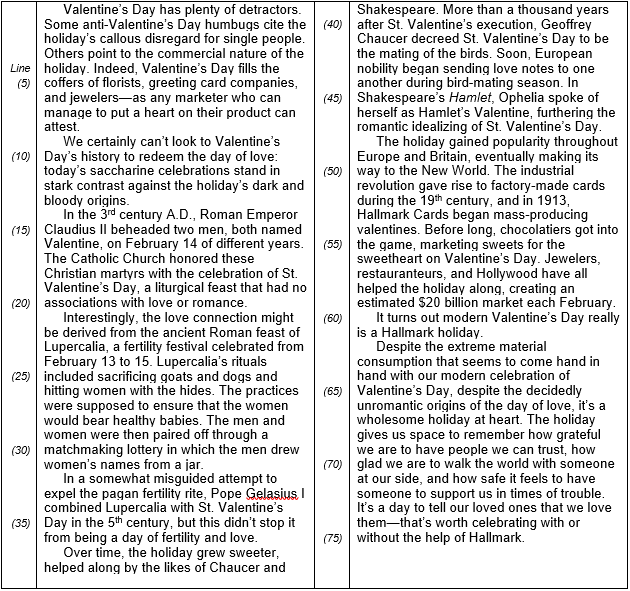It’s that time of year again: love is in the air, stores are decked with pink and red hearts, and the SAT is just a few weeks away. Inspired by the season, we’ve put together some Valentine’s Day themed SAT reading practice for you. Enjoy!

On To the Questions!
1. Which of the following best describes the purpose of the second paragraph (lines 9-13) within the context of the passage as a whole?
A. To identify the origins of modern Valentine’s Day traditions
B. To transition to a discussion of Valentine’s Day’s history
C. To offer a counterargument to the ideas presented in the previous paragraph.
D. To illustrate the connections between the origins of Valentine’s Day and today’s celebrations.
2. As it is used in line 10, “redeem” most nearly means
A. reclaim
B. absolve
C. compensate
D. extricate
3. The author most likely uses the words “saccharine” (line 11) and “sweeter” (line 37) in order to
A. establish a humorous tone through use of puns and irony.
B. subtly mock modern Valentine’s Day traditions.
C. allude to the common association of Valentine’s Day with candy or chocolate.
D. interject a more lighthearted tone in an otherwise solemn essay.
4. The passage suggests that Geoffrey Chaucer
A. was influential in starting social fads among the upper classes.
B. wished to honor St. Valentine’s martyrdom.
C. inspired Shakespeare’s interest in Valentine’s Day.
D. often wrote about natural phenomena.
5. Which of the following is NOT cited as a contributing factor to the romantic traditions of modern Valentine’s Day celebrations?
A. Lupercalia
B. Roman Emperor Claudius II
C. Geoffrey Chaucer
D. The industrial revolution
6. According to the passage, the commercialization of Valentine’s Day began when
A. Ancient Romans celebrated Lupercalia.
B. Shakespeare romanticized Valentine’s Day in Hamlet.
C. Hallmark Cards began mass producing valentines.
D. European nobility began sending love notes.
7. Which of the following sets of lines best supports your answer to the previous question?
A. Lines 21-24 (“Interestingly…15.”)
B. Lines 42-44 (“Soon…season.”)
C. Lines 44-47 (“In…Day.”)
D. Lines 52-56 (“…and in…Day.”)
8. The author most likely describes Pope Gelasius I’s decision to combine Lupercalia and St. Valentine’s Day as “misguided” (line 32) because
A. the influence of the pagan celebration remained long after the attempt to eliminate it.
B. people continued to prefer to celebrate Lupercalia instead of Valentine’s Day.
C. the pagans who celebrated Lupercalia never converted to Catholicism.
D. Valentine celebrated Lupercalia in the 3rd century.
9. Which of the following best supports your answer to the previous question?
A. Lines 14-16 (In the…years.”)
B. Lines 17-20 (“The…romance.”)
C. Lines 25-31 (“ The…jar.”)
D. Lines 35-36 (“…but…love.”)
10. Which of the following best describes the author’s attitude toward Valentine’s Day?
A. Largely dismissive
B. Vehemently opposed
C. Impartial and indifferent
D. Cheerful and celebratory
Answers and explanations
Question 1: B
The first paragraph introduces a modern perspective on Valentine’s Day. The third paragraph relates the earliest history of Valentine’s Day. The second paragraph transitions from the modern to the historical by establishing the contrast between current celebrations and the origins of the holiday.
Question 2: B
The sentence containing the word “redeem” refers back to the criticisms of Valentine’s Day in the first paragraph. The sentence says that the history of Valentine’s Day doesn’t put the holiday in any better light because the origins are “dark and bloody.” We need a word that means something similar to “put in a better light,” and choice B is the best reflection of this meaning. To absolve is to free of blame, guilt, or shame. This suits the context of the sentence: The dark and bloody origins won’t free Valentine’s Day of the shame placed upon it by its detractors.
Question 3: C
The passage as a whole does not feature a humorous tone, so the words are not establishing this tone; we can eliminate choice A. The author is generally positive regarding Valentine’s Day, so there is no sense of mocking traditions; we can eliminate choice B. The overall tone of the essay is relatively informative but not particularly solemn, so the author is not trying to lighten the mood; we can eliminate choice D. Choice C is the best answer; the terms provide subtle allusions to the common Valentine’s Day tradition of giving sweets.
Question 4: A
Lines 39-44 support this answer. After Chaucer decreed Valentine’s Day to be the mating of the birds, European nobility began sending love notes during bird-mating season, indicating that Chaucer’s writings launched a social practice among the nobility.
Question 5: B
The fourth paragraph identifies Lupercalia as a possible source of the “love connection” of Valentine’s Day, The sixth paragraph defines Chaucer’s contribution to the romantic associations of Valentine’s Day. The seventh paragraph tells us that the industrial revolution allowed Hallmark to mass produce valentines. The third paragraph tells us that Claudius II’s role was in beheading two men named Valentine, who were later celebrated as saints by the Catholic church; this contribution to the history of Valentine’s Day has no romantic association.
Question 6: C
Lines 52 to 56 define Hallmark’s mass-produced valentines as the first of the common commercial Valentine’s Day products, followed by chocolates, and eventually jewelry, Valentine’s Day dinners at restaurants, and romantic movies.
Question 7: D
See the answer to the previous question.
Question 8: A
The sentence in lines 21-24 suggests that the celebration of Lupercalia may be the origin of the romantic aspects of modern Valentine’s Day, which implies that the vestiges of Lupercalia remained long after the festival had been overshadowed by Valentine’s Day. This is further supported by lines 35-36, which tell us that Pope Gelasius I’s move to eradicate Lupercalia didn’t eliminate the pagan holiday’s influence.
Question 9: D
See the answer to the previous question.
Question 10: D
Although the first paragraph starts the essay on a negative footing, it is communicating the criticisms of “Valentine’s Day humbugs” rather than the opinions of the author. The author’s opinion is not stated until the final paragraph, in which the author writes that Valentine’s Day is “a wholesome holiday at heart” and is “worth celebrating” regardless of anyone’s criticisms. This best supports answer choice D.
Need SAT reading help?
So how did you do? Hopefully, you got every question right and are feeling confident in doing the same on your upcoming SAT. If not, don’t worry – maybe you just need a little support to make sure you’re ready to score big on test day. If you’re interested in some personalized support, C2 SAT prep is a great option!









